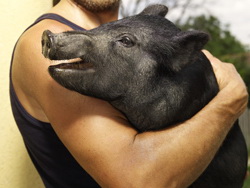Cleaning up pig breeding programmes
The revolution in genomics and mapping techniques is playing a role in improving nearly every production efficiency trait evaluated in livestock. Advances mean that pig breeders and commercial pork breeders can now avail of gene marker technology once thought to be the domain of high-tech laboratories. The 'SNPs of high utility within European commercial pig breeds' (Pigsnp) project aimed to really narrow down the search for useful traits in commercial pig breeds by using a new technique to look for single nucleotide polymorphisms (SNPs). As the name suggests, SNPs occur when there is a difference in only one nucleotide or base pair in the DNA strand. The implications of SNP identification are very significant indeed. The variation to be found in genomes of all species is astronomical in scale and animal and plant breeders can tailor their programmes to the exact recipe of traits required. Pigsnp looked at 158 samples of DNA collected from five major pig breeds, Duroc, Pietrain, Landrace, Large White and Wild Boar. They availed of the high-throughput Illumina Solex sequencing technology that provides a large surface area for many thousands of parallel chemical reactions. Over 350,000 high confidence SNPs were isolated and, together with polymorphisms from other sources, a database with more than half a million SNPs has been constructed. Using the PorcineSNP60 beadchip to validate the SNPs and determine genetic merit, Pigsnp achieved some 43,000 SNPs that were identified and these have been made freely available to the scientific community for research purposes. Of these, almost 4,500 were confirmed to be breed specific. On a practical basis, one genetic trait that breeders want to eliminate from their stock is boar taint which confers an unpleasant taste to the meat due to certain testicular anabolic hormones. The beadchip was used to genotype pigs for potential boar taint. Use of genetic markers will eliminate the need to castrate animals, to date the only way of making sure that the meat will not taste unpleasant. Although the pig genome requires additional analysis and annotation for precise genes to be pinpointed for undesirable traits, the PorcineSNP60 beadchip designed by Pigsnp has undeniable practical uses in the pig breeding industry. Extending the boundaries of genotyping to that of the single nucleotide can no doubt be extended to other breeding programmes and genomic study generally.







